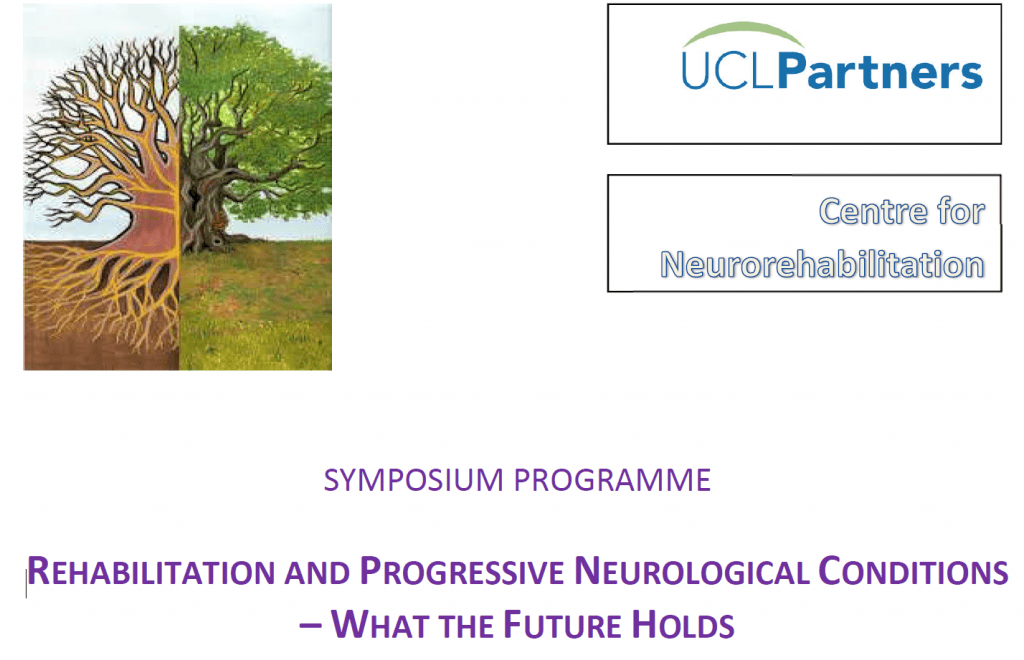Students visit the UCLP Centre for Neurorehabilitation Symposium
By rmapapg, on 22 December 2015
By Ashkan Pakzad and Samuel Gunning
The Department of Medical Physics and Biomedical Engineering generously funded two students to attend a Neurorehabilitation Symposium organised by UCL Partners. The students were Ashkan Pakzad (MSci Medical Physics) and Samuel Gunning (iBSc in Medical Physics).
Ashkan takes up the story:
Although the conference aimed to cover neurodegenerative diseases as a whole it often revolved around support and provision for those that suffered from multiple sclerosis, a disease that encompasses most aspects of any neurodegenerative condition.
As it was my first ‘real’ conference I was already nervous about the 9 hours ahead only to find out that my experience was about to curve further; I felt like an outsider, not because I was a student amongst clinicians bound to become consultants but because I was a physicist. The speakers all had the idea that they were informing clinicians rather than intruding academics but none the less I managed to keep up with their abbreviated jargon.
A wide range of speakers from top international consultants to graphic designers with no official qualifications in science working with clinics had a slot. It all started off with a few words from a retired prestigious academic, giving his take and definition on rehabilitation for neurodegenerative disease as he urged that such cases needed to not be over simplified and not be redefined into something new and that these diseases often should not even be considered as a disease but to take them as they come and to refrain from a systemic approach.
One particular speaker that I enjoyed had highlighted the need to conduct research with care as large budgets have been wasted in the field due to indirect questionnaires that measured outcomes too broadly and thus those studies had given imprecise results to critically compare techniques therefore leading to unsustainable conclusions. In fact, he claimed that much was to be learnt from experiments in physics coupled with rigorous statistical analysis when planning medical experiments.
Stalls were set up in between speakers offering close inspection of incontinence technology and several industry representatives were presenting their technologies as fast as possible with no time to lose. Overall this opportunity has been an eye opener just presenting the great wealth of knowledge delivered intensely and often ready digested thanks to talented speakers whom all have a different perspective to offer.
Samuel continues after lunch:
The symposium was approached from a greater clinical perspective after lunch. Whereas before lunch had been focused primarily on the technology that is currently circuiting, as demonstrated in Helen Paterson’s lecture on Augmentive and Alternative Communication, or the general role rehabilitation should have in neurological diseases, after the break we started to pinpoint specific conditions or symptoms which can be overcome with rehabilitation.
We began with the management of incontinence – bladder first and then bowel – issues which are quite often left untreated due to them being regarded as “private” matters. The lectures had very different structure with the first summarising the main surgical methods which would follow the failure of conservative treatments and the second concentrating on the technological interventions used, sometimes with many being used in parallel. The reason for this is, I believe, is the far more advanced care algorithm used for bowel management.
Following this we moved onto the complicated management of pregnancy in women with Charcot-Marie-Tooth disease. To a medical student this was very interesting as CMT, a hereditary sensory and motor neuropathy with peroneal muscular atrophy as well, is a perplexing condition. To then understand the methods to overcome the disease, or at least reduce the impact of some of the many symptoms attributed to CMT, was a highlight.
Moving away from disease, the next session addressed the analysis of research, specifically research into emerging rehabilitation technologies. With doctor autonomy currently growing, the ability to differentiate a potentially hugely beneficial treatment method from a false one is hugely important. The objective of the lecture, I believe, was to emphasise how an outcome was completely reliant on the measurement process and how you must first decide the outcome you want before indentifying the measurement process, a thinking point I later applied to my own research.
To finish, two support groups were identified. The key purpose of these groups is to support and to facilitate learning of how to manage oneself when struggling with a disease or symptom.
The second half of the day was much more applicable to my own learning, with such symposiums contributing to the compulsory CPD points I will one day have to accumulate. Despite this, the technological aspect was what I had expected. Having spoken to the other attendees, the majority were practicing doctors, physiotherapists and nurses, and I think the day was perfectly focused to them. For a student it was important to see how the stuff we are learning about is applied in a clinical situation as this is the eventual goal of any studying and can help focus and encourage. Furthermore, with presentations looming at the end of next term, the symposium was a valuable opportunity to identify positive presentation methods and those to avoid as well. All in all a fantastic day, filled with a wide variety of interesting topics.
Thanks to the Centre for Neurorehabilitation who agreed to offer a student discount on the registration fee.
 Close
Close


